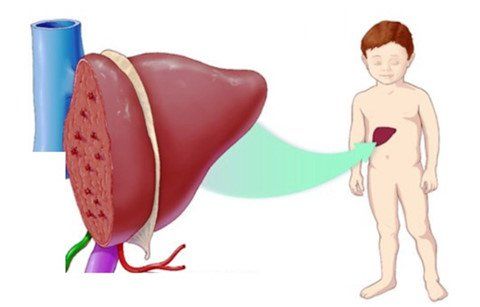This is an automatically translated article.
Article written by Dr. Tran Trung Kien, Vinmec Institute of Stem Cell & Gene Technology
Congenital biliary atresia causes impaired liver function and leads to cirrhosis. This is a complex disease with unknown etiology. Observations show an increased prevalence of the disease in regions and races such as in Southeast Asia and the South Pacific Ocean region.
Congenital biliary atresia is a disease that presents in early infancy with scarring or obstruction of the intrahepatic or extrahepatic bile ducts. MS was first described by physician John Thomson in 1892 (Thomson, 1892). Bile acids are produced in the liver and transported by the bile ducts to the gallbladder for storage and to the small intestine to help digest food. Therefore, when the bile duct is blocked, bile cannot flow into the small intestine, leading to cholestasis in the liver. As a result, liver function declines and cirrhosis progresses. It is a progressive inflammatory and fibrous disease of the biliary tracts and is one of the most potentially life-threatening and complicating diseases in young children.
According to studies, the rate of children with CKD varies greatly between different populations in the world. In which, the frequency of disease occurrence in Southeast Asia and the Pacific is the most common. The frequency of occurrence in Taiwan is 1 in 5000 births. Meanwhile, North America and Western Europe have a lower frequency, only from 1/14,000 to 1 in 20,000 births. Currently, there is no study on the frequency of occurrence of PE in the Vietnamese population. The prevalence rate is thought to be about 1/2,400 children born, equivalent to countries in the Pacific region. Although the disease has been discovered for a long time, studied and treated a lot, the cause and mechanism of PAD are still not clearly defined. It can be caused by viral infections, autoimmune conditions leading to destruction of the bile ducts, or genetic abnormalities or genetic-environmental factors (Mezina & Karpen, 2015).

Teo đường mật bẩm sinh khiến chức năng gan bị suy giảm
In terms of genetics, recent studies have shown that genetic factors have a strong correlation with the clinical manifestations of the disease. Studies have also shown that PPD does not follow a Mendelian inheritance pattern due to the lack of familial and co-expression in identical twins (Fallon et al., 2013). However, the world's medical literature has recorded some cases of disease related to family. This suggests autosomal recessive inheritance or a combination of genetic and other factors (Ando et al., 1996; Gunasekaran et al., 1992; Lachaux et al., 1988; Smith et al., 1991).
Recently, a number of studies applying genomic sequencing technology have found some mutations in the ABCB4 gene in CKD patients (Mezina et al., 2014). A study on 20 patients with DR in Thailand, discovered 13 mutations in 9 genes related to the expression of DR, including genes: JAG1, MYO5B, ABCC2, ABCB11, UG1A1, MLL2, RFX6, ERCC4 and KCNH1 ( Sangkhathat et al., 2018). A study in US and Canadian children found 15 genes in 12 patients including the genes CFC1, HNF1B, ZIC3, ACVR2B, BCOR, DNAH11, HSPG2, HYDIN, IFT172, LRP2, PKD1, RPGR, SHROOM3, TBX5, ZFPM2. (Berauer et al., 2017). In addition, studying gene correlation and disease expression on ethnic Han and Chinese people found a close correlation between the disease and some mutations in the ADD3 gene on position 10q24.2 (Cheng et al. ., two thousand and thirteen). Another study of 171 patients and 1630 controls in a European population showed a strong correlation between the rs7099604 variant in the ADD3 gene (Tsai et al., 2014). In addition, the correlation between the variant rs17095355 on the XPNPEP1 gene at position 10q24 with PE was also detected (Garcia-Barcelo et al., 2010).

Yếu tố gen có mối tương quan mật thiết với biểu hiện lâm sàng của bệnh
In summary, CKD is a complex disease with unknown etiology. Observations show an increased prevalence of the disease in regions and races such as in Southeast Asia and the South Pacific Ocean region. Although there is evidence of gene involvement in disease expression, genetic and environmental interactions may play a role. With the strong development of new generation gene sequencing technology, it is hoped that in the near future there will be many new and deeper discoveries about the causes of CKD in children.
For effective treatment, you should take your child to a reputable medical facility. Vinmec International General Hospital is a high-quality medical facility in Vietnam with a team of highly qualified medical professionals. , well-trained, specialized in domestic and foreign, rich in experience.
A system of modern and advanced medical equipment, possessing many of the best machines in the world, helping to detect many difficult and dangerous diseases in a short time, supporting the diagnosis and treatment of doctors the most effective. The hospital space is designed according to 5-star hotel standards, giving patients comfort, friendliness and peace of mind.
Please dial HOTLINE for more information or register for an appointment HERE. Download MyVinmec app to make appointments faster and to manage your bookings easily.













